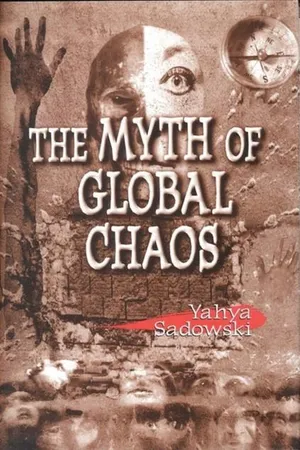
- English
- ePUB (mobile friendly)
- Available on iOS & Android
The Myth of Global Chaos
About this book
When the Cold War ended in 1989, American hopes for a new world order were quickly disappointed. A new wave of violence soon erupted, engulfing places from Rwanda and Somalia to Chechnya and Bosnia. These new ""clashes of civilizations, "" fundamentalist jihads, and ethnic massacres appeared to be more savage and less rational than the long twilight struggle with the USSR, during which Washington's adversary was clearly identified and relatively predictable.
In an effort to understand these post-Cold War conflicts and to advise the government on how to deal with them, a new school of foreign policy thought has developed. Dubbed ""chaos theory, "" it argues that the much heralded processes of globalization are actually breeding a reaction of irrational violence. Thus, the spread of Western cultural icons through new electronic media often shocks and offends moral sensibilities in traditional societies. The explosive growth of international commerce has triggered a wave of migration and urbanization that throws together people from different cultures and fertilizes xenophobia. Chaos theory has already won converts in the U.S. military, the intelligence community, and the foreign service. Its influence has been manifest in an array of policies, particularly during the U.S. engagement in Bosnia.
But chaos theory is mostly wrong. In this book, the author outlines the growth of chaos theory and its growing influence, and then provides a thorough empirical critique. Using detailed studies of Bosnia and global comparisons, he shows that globalization has not played a decisive role in fueling recent conflicts. Indeed, journalists' impressions notwithstanding, there is no evidence that since 1989 warfare has become more savage or even more frequent. The advocates of chaos theory are thus urging the U.S. to invest in preparing for a threat that is largely mythical--a strategy that is at least wasteful and potentially dangerous. The author argues that the most use
Frequently asked questions
- Essential is ideal for learners and professionals who enjoy exploring a wide range of subjects. Access the Essential Library with 800,000+ trusted titles and best-sellers across business, personal growth, and the humanities. Includes unlimited reading time and Standard Read Aloud voice.
- Complete: Perfect for advanced learners and researchers needing full, unrestricted access. Unlock 1.4M+ books across hundreds of subjects, including academic and specialized titles. The Complete Plan also includes advanced features like Premium Read Aloud and Research Assistant.
Please note we cannot support devices running on iOS 13 and Android 7 or earlier. Learn more about using the app.
Information
Table of contents
- Foreword
- Tables
- Figures
- 1. Triumph and Despair
- 2. Popularizing Chaos
- 3. Anomie and Social Violence
- 4. Globalization and Culture Conflict
- 5. The Varieties of Global Chaos Theory
- 6. The Policy Implications of Global Chaos
- 7. The Age of Fratricide
- 8. Globaloney
- 9. Post-Cold War Patterns of Conflict
- 10. The Mythology of Ethnic Conflict
- 11. From Chaos to Complexity
- 12. Conclusion
- Appendix
- Notes